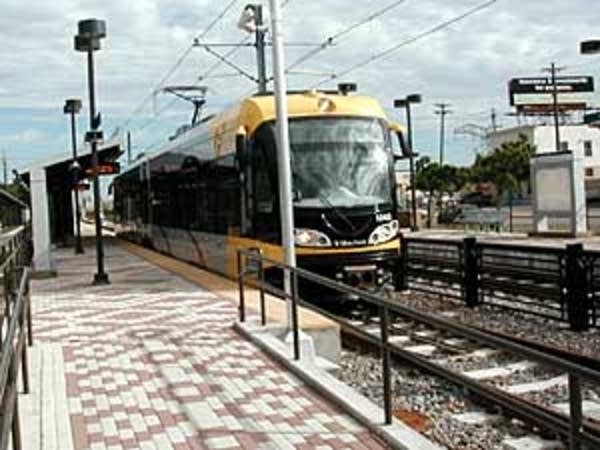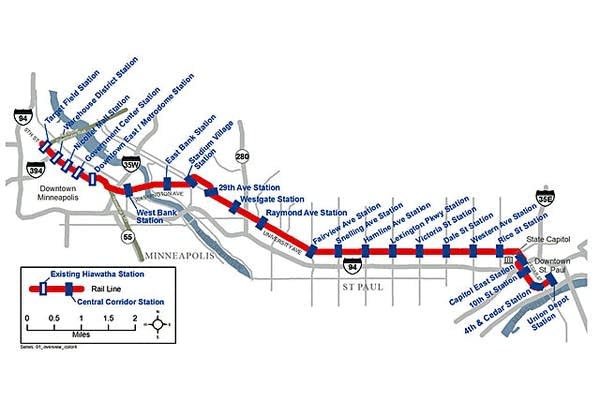Compromises move Central Corridor light rail toward a milestone

A transit mall on Washington Avenue through the University of Minnesota campus is a compromise. The U of M is on board for the idea instead of a much more costly tunnel.
The mall is a good compromise, according to Metropolitan Council member Kirstin Sersland Beach whose district includes a large portion of the line.
"A transit mall that is some combination of pedestrian, rail transit, bus transit, bike transit is becoming more and acceptable if not preferable," she says.
U of M officials lobbied long and hard for the tunnel. They worried a light rail line on Washington Avenue competing with hundreds of buses, emergency vehicles trying to get to the U hospital and thousands of pedestrians would be a mess.
Create a More Connected Minnesota
MPR News is your trusted resource for the news you need. With your support, MPR News brings accessible, courageous journalism and authentic conversation to everyone - free of paywalls and barriers. Your gift makes a difference.
A transit mall would limit access to traffic and would slim the Central Corridor price tag by at least $150 million, one of the cost estimates for a tunnel.

Keeping a lid on Central Corridor costs in the view of many is paramount. The reason is the Federal Transit Administration is being asked to pay half the cost of the $909 million project.
Competition for scare federal transit dollars is red hot and the FTA doesn't allow much wiggle room in its formula for granting the money.
A couple of weeks ago the FTA shocked backers of a big light rail project in the suburban Washington D.C. area. The federal agency was not satisfied with its numbers and withdrew its support. If the FTA has issues with the Central Corridor project they won't hesitate to send the Met Council back to the drawing board, says Met Council chairman Peter Bell.
"They will delay the project and I remind all of our partners the cost of that is $40 to $50 million a year," he says.

Keeping a lid on Central Corridor costs may cause the Met Council to approve a plan that disappointments some St. Paul neighborhood residents. They've lobbied for three additional stations along University avenue in addition to the 16 now being planned along the route. The compromise may include putting infrastructure for the three additional stations in place and building them later as funding becomes available. Building the extra stations would cost extra money and would add time to the trip, both factors in the FTA's formula for deciding winners and losers.
And there are plenty of other cities out there who, like St. Paul and Minneapolis, want to be FTA winners, according to Maria Zimmerman, a native of rural Waseca in southern Minnesota who is now vice president for policy at Reconnecting America.
The Washington D.C. area study group focuses on integrating the nation's transportation network and features rail options prominently on its Web page. Many cities have transit expansion programs with features the FTA likes to see - big projected ridership numbers and a dedicated source of local funding, Zimmerman says.
"Houston and Denver have very ambitious plans to build numerous lines all at the same time in a very short period and are not only looking for not only federal funds but other funds," she says.
However Met Council member Kirstin Sersland Beach says the FTA has made very soothing sounds about the Central Corridor's chances.
"They've been quite candid with us that it's one of the most promising new start projects that they've seen in the nation," she says.
So, here's one scenario of what may happen between today and six years from now when the Central Corridor light rail project may actually carry its first riders.
The Met Council is expected to approve a $909 million Central Corridor light rail plan that includes a transit mall rather than a tunnel under Washington Avenue and elimination of one stop in downtown St. Paul. The line would stop just short of going all the way to the Union Depot in Lowertown St. Paul.
If approved, the plan moves on to more detailed preliminary engineering.
Then in September, chairman Peter Bell says, the Met Council will send an application to the FTA asking to be allowed to enter the final design phase.
"The feds will make a decision whether we approved to go into final design about February of 2009," he says.
Winning final design approval from the FTA is a big deal. It means, among other things, Minnesota, Ramsey and Hennepin Counties and all the other partners have made lots of progress on nailing down their half of the project's cost. That's about $450 million. That greases the tracks for a full funding grant agreement with the federal government.
The result could be construction beginning in 2010 and trains running in 2014.
